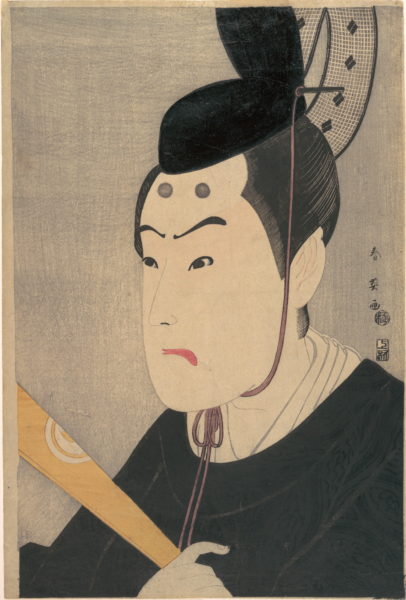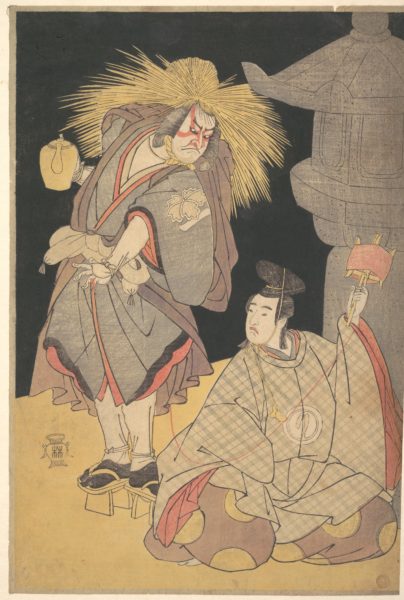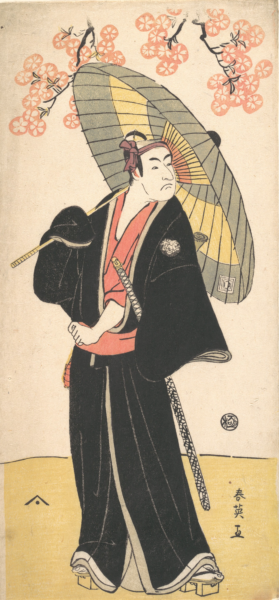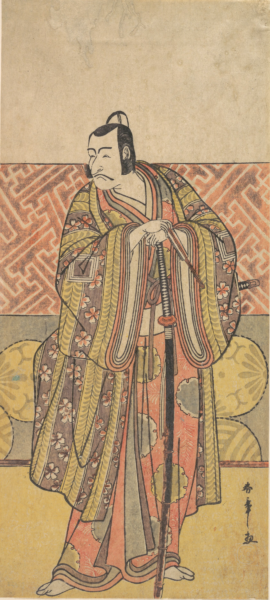With the exception of a small number of prints dating from around 1770, and then again from about 1790, most prints of both Bunchō and the Katsukawa do not feature any marks of publishers. Would this suggest that most of these prints were in fact somewhat like private publications, not available through commercial publishers, and rather directly distributed by the fan clubs of the kabuki actors? This might well have been a common practice in the early years of nishikie colour prints. As for Bunchō (see the previous issue, Part 3A for the reference), we can only identify some 52 designs out of a total of 395 being issued with some publisher’s mark, dating from 1769 (7 prints), 1770 (13), 1771 (6), 1772 (5), and 1773 (1). This is also what we see with Harunobu’s prints, where we can only find some 101 prints with a publisher’s mark out of a total of 843 known prints (mostly in his prints in the mizue 水絵 and benizuri printing technique, and only 11 among his 720 nishikie colour prints), whereas, by decree, publishers’ marks were obligatory from XI/1720 for both prints and books issued commercially. It is then tempting to conclude that most prints in the new technique, at least in the initial years, were not distributed commercially, but rather among members of private clubs, such as people around the hatamoto Ōkubo Tadanobu aka Kyosen 1722-1777, 旗本大久保忠舒巨川 in the case of Harunobu, and members of fan clubs of kabuki actors in the cases of Bunchō and Shunshō and his Katsukawa-workshop colleagues. It is probably also no coincidence that we begin to see the first colour printed books issued by commercial publishers around the same time, from 1770.
But maybe we should also have a look at the days of benizurie and see which role commercial publishers were playing then. It then appears that only 11.5% of benizurie, that is 103 out of a total of 1205 prints, was issued without any mark of a publisher. This might well confirm that the absence of publishers’ marks on most early nishikie indicates that we are, indeed, looking at some kind of private publication, at least some print that was being distributed privately. On the other hand, how exactly this worked is difficult to say. There must have been someone acting as a producer, who organized the cutting of the blocks, provided the paper needed, and eventually oversaw the printing, as we also see this with surimono prints, e.g. Kubo Shunman 窪俊満 in Edo and Tani Seikō 谷清好 in Osaka. Most likely these were established publishers who should well be able to handle all this, but couldn’t act as their publisher as it were the clubs who commissioned these and were paying the costs and were consequently in charge of the distribution as well. Thus, these prints were made by subscription, like, for example, upon an announcement that Katsukawa Shunkō would make a triptych composition after this and this play that was just staged yesterday at this and this theatre?
According to Arihara Kogan 1829-1922 在原古玩, Harunobu’s chūban prints cost 160 mon 文 at the time, whereas prints by other artists in the hosoban format cost 12 mon and ōban prints 24 mon (cited after Tanabe Masako 田辺昌子 in the Harunobu exhibition catalogue, Chiba City Museum of Art, 2002, 275 and 307). This may seem interesting, but on the other hand, it is also a little puzzling. How could one chūban print by Harunobu cost the equivalent of more than six and a half ōban prints by any other artist – and I always learned that format is a factor, and six and a half ōban prints equal thirteen chūban sheets, that is the printing blocks, the cutting of the line and colour blocks, and the printers working a number of days, and the paper also makes for a good part of the price, as do the pigments… It is also not very clear what exactly the source of Arihara’s statements is (though I must still try to locate a copy of his article). So I prefer to forget about this, it simply makes no sense (to me, at least).
Assuming that also the hosoban and ōban prints are full colour nishikie, we must realize that from 1772 a new set of standard formats of paper was introduced, as a necessary standardization that would enable the badly needed commercial production of colour prints, yes, indeed, commercial distribution, no longer just catering to only private subscribers. As a consequence, the traditional ōbirobōsho 大広奉書 sheet measuring 44 x 58 cms and yielding a chūban sheet of 290 x 220 mms, as we can find in the Art Institute of Chicago’s circa 1766 Zashiki hakkei 座敷八景 series of 289 x 218 mms, was replaced by ōbōsho 大奉書 sheets measuring 39 x 53 cms and yielding a chūban sheet of 265 x 195 mms that we find in Bunchō’s post 1772 chūban designs, and most other chūban designs, for that matter. And from then, a standard ōban print measures 390 x 265 mms. And the benizurie hosoban measuring 330 x 153, as one third of a Mino sheet of 330 x 460 would from then measure 330 x 156, exactly the third of a kobōsho sheet 小奉書, which, alas, hardly helps us date these hosoban prints on the basis of their measurements. Once this standardization is a fact, print production is gradually getting in the hands of commercial publishers, as we can see in the works of Isoda Koryūsai, Torii Kiyonaga, and Kitagawa Utamaro. And towards the late 1780s, when cultural life in Edo is more and more under close scrutiny of the government, leading to the Kansei Reforms concerning publishing of V/1790, even the Katsukawa artists have to give up their private business of exclusive catering to the kabuki fan clubs. From then, we only see privately distributed prints in the form of picture calenders, egoyomi 絵暦, mostly in the 1780s and 1790s, and kyōka surimono 狂歌摺物 from the 1790s on.

The Katsukawa artists, as well as Bunchō and Sharaku, also worked in other formats than just hosoban. Both Bunchō and Shunshō, Shunkō 春好 act 1772-99 (?) and Shunei 春英 act 1783-1808 (?) designed quite a few works in the chūban format, and as the aiban 330 x 235 mm format came into use, the Katsukawa artists also used this format quite regularly as an intermediate format in between the ōban and chūban sheets. Shunshō’s use of the ōban format probably only dates from the early 1780s, in a series of prints portraying actors back-stage and a number of prints of sumō wrestlers. Moreover, as is well-known, Sharaku made his first appearance in the world of prints with a group of no less than 28 ōban prints with a mica ground portraying actors after performances in the fifth month of 1794, a feat unmatched by anyone else either before or after him. These so-called ōkubie 大首絵 or ‘large head’ portraits were probably an innovation that must be attributed to Katsukawa Shunkō, as we can learn from the comments in Kabuki nenpyō in the first month of 1789, stating that ‘for the fame of Tamejūrō, the kyōka poetry clubs of Edo had Katsukawa Shunkō make portraits of Tosshi [Sawamura Sōjūrō III], Okuyama [Asao Tamejūrō], Rokō [Segawa Kikunojō III], Tojaku [Iwai Hanshirō IV], and Mimasu [Ichikawa Danjūrō V], and distributed 500 of these,’ privately that is 為十郎大評判にて江戸狂歌連中より訥子奥山路考杜若三升五人の似顔を勝川春好に描かせ摺物五百枚を贈る (KN 5:81). And may we then conclude that an edition of 500 was really exceptional and that maybe something like 300 or 350 was more like common practice? Or could it be, as my friend and loyal reader Paul Belien suggested, that each of the designs was printed in an edition of one hundred and we thus get to the figure of five hundred for the five prints. Indeed, raising the question again how costly these prints were. And, of course, these ōban prints cost much more than a standard hosoban sheet. Still, the designers, block-cutters and printers all had to be paid, plus the printing blocks, the paper and the pigments, so there must have been a break even point somewhere. Anyway, I have never believed that skipping one bowl of noodles would allow one to buy another woodblock print fairy-tale.

But let us now again have a look at the prints of actors in role designed by Buncho, the Katsukawa workshop, and Sharaku:
| What | I | II | III | IV | V | VI | VII | VIII | IX | X | XI | Prints | |
| 1697 1760 | tane urushie | 42% | 9% | 5% | 29% | 563 99.5% | |||||||
| 1742 1769 | benizurie | 27% | 9% | 9% | 5% | 6% | 35% | 854 100% | |||||
| 1764 1796 | Katsukawa Bunchō Sharaku | 17% | 6% | 6% | 7% | 9% | 6% | 40% | 794 99.5% |

As we already saw in Part 3A, the print buying audience keeps losing interest in prints after the New Year performances. Could it be that New Year’s egoyomi and surimono and the new novels of various kinds released in the first month were attracting more attention and that this made that prints after the New Year performances now make up for only 17% of the annual production, versus 40% for prints after the kaomise 顔見 performances marking the opening of the kabuki season. The interest for prints after the second and third months drops, the fifth month is on the rise, and new is prints after performances in the eighth month. In summary, the buying public is still moving, or is it the commercial publishers who cause these shifts, trying to reach a wider audience than just members of the fan clubs of specific actors?
Otherwise, looking a bit around at other developments, it is quite remarkable that most Katsukawa artists hardly lent themselves to illustrations of popular novels, with the exception of Shunjō (春常 13 in the years 1778-92), Shunrō 春郎, the later Hokusai (34 novels in the years 1780-97), and Shunei (33 in the years 1782-94). Shunshō, the head of the atelier, made the illustrations to only six popular novels and designed 17 picture books and 19 albums of erotic content, indeed making him an artist of the ‘old’ tradition. Otherwise he seems to have been in very strict control, only Shunchō 勝川春潮, who almost did no prints of actors, was allowed to do the illustrations of seven popular novels, in addition to making three picture books and 14 erotic works in the years 1783-98.

The Katsukawa tradition, and certainly the branch devoted to the theatrical world, died out soon after the decease of Katsukawa Shunshō in Kansei 4, eighth day of the twelfth month 寛政四年十二月八日, that is 19/1/1793. His favourite pupil Shunkō suffered from a stroke that paralyzed his right arm in 1791 and stopped designing prints, after some training concentrating on painting instead. And his second choice, Shunei, also gave up soon as they lost their traditional audience to the upcoming Utagawa tradition of prints of actors, led by Utagawa Toyokuni 歌川豊國 act 1787-1825 and Utagawa Kunimasa 歌川國政 act 1795-1804, the subject of the next instalment. And, indeed, why not Shunrō, whom Shunshō always put in a far corner of his atelier, just allowing him to make the cheapest possible actor prints so that the Katsukawa atelier would also cater to a different audience and have some extra income – the later Hokusai I mean, who then left the Katsukawa workshop to establish a fully independent tradition by himself, but not in the world of actors.